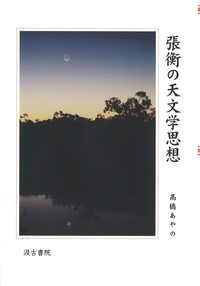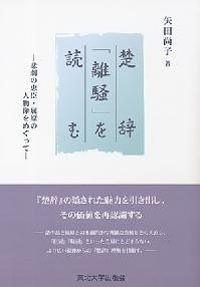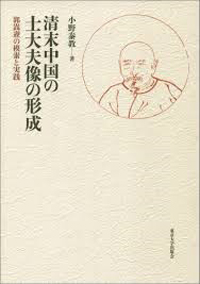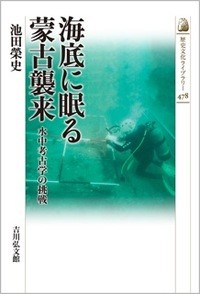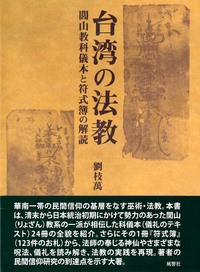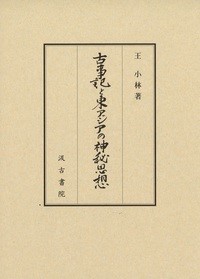國外近期漢學出版物(三十三)
2018·12—2019·1
1、張衡の天文學思想
時 間:2018年12月
出版單位:東京:汲古書院
作 者:髙橋あやの 著
內容簡介:
序(吾妻重二)
序章 本書の立場
第二章 『霊憲』と『渾天儀』の比較
第三章 渾天說の天文理論
第四章 渾天說と尚水思想
第五章 張衡「思玄賦」の世界観
第六章 張衡と占術
第七章 張衡佚文の考察
第八章 『海中占』關連文獻に關する基礎的考察
終章 本書のまとめ
2、楚辭「離騒」を読む——悲劇の忠臣·屈原の人物像をめぐって
時 間:2018年11月
出版單位:仙臺:東北大學出版會
作 者:矢田尚子 著
內容簡介:
第1部 楚辭「離騒」の天界游行とその解釈をめぐって
第1章 「離騒」の天界游行はどのように解釈されてきたか
第2章 シャーマニズム論から見た「離騒」の天界游行解釈
第3章 楚辭「離騒」の天界游行に見える「上下」について
第4章 楚辭「離騒」に見える「求策」について——君臣遇合例を中心に
第5章 楚辭「離騒」の「求女」をめぐる─考察
第6章 楚辭「遠游」と「大人賦」の天界游行
第7章 『淮南子』に見える天界游行表現について
第2部 悲劇の忠臣——屈原像の形成
第8章 王逸『楚辭章句』以前の屈原評価
第9章 楚辭「卜居」における鄭詹尹の臺詞をめぐって
第10章 笑う教示者——楚辭「漁夫」の解釈をめぐって
第11章 「無病の呻吟」——楚辭「七諫」以下の五作品について
第12章 孔子と屈原
終章
3、清末中國の士大夫像の形成:郭嵩燾の模索と実踐
時 間:2018年11月
出版單位:東京:東京大學出版會
作 者:小野泰教 著
內容簡介:
序章 郭嵩燾による士大夫像の模索
第I部 士大夫の社會的地位の回復を目指して
第一章 士大夫の商賈化への批判
第二章 士大夫どうしの關系悪化への危機感
第II部 士大夫像の模索と西洋政治像
第三章 渡英直前の郭嵩燾と劉錫鴻の士大夫像
第四章 郭嵩燾·劉錫鴻の士大夫像とイギリス政治像
第五章 イギリス政治像と士大夫批判
第III部 士大夫像の模索と経學·諸子學
第六章 民を治める方法の模索——『大學』『中庸』解釈
第七章 禮の実踐——郭嵩燾の宗法論
第八章「是非の辯を押し付けること」と「己を俗と同じくすること」の克服——『荘子』解釈
終章 清末中國の士大夫像の形成とその意義
5、海底に眠る蒙古襲來:水中考古學の挑戦
時 間:2018年9月
出版單位:東京:吉川弘文館
作 者:池田榮史 著
內容簡介:
鎌倉時代の蒙古襲來時に沈んだ元寇船が発見された長崎県の鷹島海底遺跡。當時の造船技術や積荷などの解明に大きな期待が寄せられるが、水中という困難な環境でいかに調査は行われたのか。音波探査やダイバーによる発掘作業、映像撮影、実測図作成、船體保存など、試行錯誤で進められた現場の様子を紹介。水中考古學の手法と今后の可能性を探る。
7、臺灣の法教:閭山教科儀本と符式簿の解読
時 間:2019年1月
出版單位:東京:風響社
作 者:劉枝萬 著
內容簡介:
第一章 臺灣の法教について
一 前言
二 法師
三 教派
四 巫術
五 結語
第二章 臺灣の法教資料——閭山教科儀本(劉枝萬述/石井昌子編)
はじめに
一 資料の概要
二 科儀本の分類と配列
第三章 所蔵科儀本
01 『頭壇請神書』 一九二二·四三頁·〈請神〉
02 『請神書全本』 一八七五·一八頁·〈請神〉
03 『請八仙 大獻 小獻』 一八九八·一七頁·〈請神·饗応〉
(中略)
13 『送神書』 年代なし·一五頁·〈送神〉
14 『雞歌書全部』 年代なし·四二頁·〈辟邪〉
15 『無題(符式簿)』 年代なし·一一九頁·〈符式〉
(中略)
22 『離房書科 全部』 一八九八·三五頁·〈教壇の內部文書〉
23 『無題』 一九〇〇·四〇頁·〈斷簡〉
24 『無題』 年代なし·四八頁·〈斷簡〉
●后編 符式簿の解読
第四章 総說
一 符式簿とは
二 所蔵符式簿について
三 符令とは
四 符令の材料
五 所蔵符式簿の材料
六 符紙の材質と色
七 符令の書寫器具
八 符式の文字·記號について
九 符令の薬用
一〇 符令の構成と天人相關的宇宙観
一一 合成偽字と辟邪
一二 所蔵符式簿の特色および解說にあたっての方針
第五章 各符の解說
1號符「玉帝勅……合家平安」(保身符)
2號符「奉玉帝勅……法斬邪鬼」(五雷平安符)
3號符「奉勅令、五雷鎮煞……妖邪鬼怪滅亡」(五雷鎮煞符)
4號符「奉勅令、五雷大將軍斷……妖邪滅亡」(五雷鎮煞符)
5號符「奉勅令、五雷大將軍追収……妖魔鬼怪精亡」(五雷収妖符)
6號符「九天玄女……押退麻煞三煞消除」(治喪門麻衣煞符)
7號符「佛勅北斗……滅邪無遺」(治病符)
(中略)
53號符「庵佛令……神符退災」(退熱治病符)
54號符「勅令臨水、護身神符、清吉平安」(水符、安胎符)
55號符「佛勅令……押出」(治病符)
56號符「欽奉玉皇鸞駕……親到中堂奉神位」(太歳符)
57號符「収除天下無道鬼急消」(辟邪符)
58號符「勅五雷兵……符到奉行」(押煞治病符)
59號符「治無名腫毒、消痳鬼悪毒」(辟邪治病符)
60號符「佛勅令、押斬年家三煞」(治病保身符)
(中略)
117號符「雪山圣者降雪、來食心中退煞」(水符)
118號符「北方壬癸到……年月日時吉」(水符)
119號符「勅令、鬼魅出他鄉……主人無傷」(押煞斷路符)
120號符「佛先師發起五方兵馬……追収妖魔邪鬼滅亡」(鐵甲符、鐵甲兵符)
121號符「紫微交厄靈帝……斬妖精」(発兵符)
122號符「勅星將軍、鐵甲兵·六丁六甲収邪」(発兵符)
123號符「□破天……収邪押煞斬妖精」(発兵符)
8、古事記と東アジアの神秘思想
時 間:2018年12月
出版單位:東京:汲古書院
作 者:王小林 著
內容簡介:
第一章 『古事記』と緯書
一 『古事記』成書の謎
二 反正記の小さな纟口
三 神々の風貌
四 各種文獻に見る異常な歯
五 『日本書紀』の天皇描寫
六 古代中國の異常風貌
七 反正記の表現と緯書
八 「貫珠」が意味するもの
九 『古事記』における異常風貌說の機能
十 記紀における緯書の受容
(一)神武東征伝承と緯書
(二)「ながひと」考——建內宿禰伝承と讖緯思想
十一 『懐風藻』の場合
第二章 『古事記』と朝鮮史料
一 反正記と尼師今伝說
二 朝鮮史料·渡來說話と緯書
三 脫解王伝承が語るもの
四 骨品と緯書
五 『三國史記』に見る井戸と龍
六 『三國遺事』に見る龍
七 井戸と王権·符命
八 井戸、池、川、海と昆侖の水界
第三章 『古事記』と神仙思想
一 瑞井と変若水·醴泉と天つ水
二 上代文獻に見る井戸
三 孤立した仙境
四 「登岐士玖能迦玖能木実」伝承の意味
五 洞天·地脈·水界を持たぬ日本の龍
六 龍との關系を絶たれる反正天皇
七 龍と「天つ日嗣」の天下
八 龍と革命の思想
九 異常風貌說の変容——「長人」から土蜘蛛·酒呑童子へ
十 古代東アジアにおける神秘思想のあり方
第四章 『古事記』と『帝王世紀』
一 『古事記』は歴史書か
二 『古事記』の核心は何か
三 「帝紀」とは何か
四 反正記と『帝王世紀』の接點
五 『帝王世紀』の歴史敘述
六 『帝王世紀』の內容構成と『古事記』
七 『帝王世紀』の源流——葉書·牒
八 『帝王世紀』の達成
九 『帝王世紀』の生成論と緯書
十 「有圣徳」の継承、発揚と緯書
十一 『古事記』の生成論と緯書
十二 『古事記』の文章表現と『帝王世紀』
十三 『上宮圣徳法王帝說』の場合
十四 太安萬侶が果たした使命
9、西夏建國史研究
時 間:2018年12月
出版單位:東京:汲古書院
作 者:巖﨑力 著
內容簡介:
序文
第一部 建國前史の研究
第一章 隋唐時代のタングートについて
第二章 夏州定難軍節度使の建置と前后の政情
第三章 唐最晩期のタングートの動向
第四章 五代のタングートについて
第五章 夏州定難軍節度使の終焉と豊州蔵才族の抬頭
第二部 李継遷の建國運動始末
第一章 李継遷の登場
第二章 李継遷の外交戦略
第三章 李継遷の苦闘
第四章 李継遷の領域経営と北部河西タングート諸部族の帰趨
第五章 李継遷の憑陵と挫折
第三部 西夏の建國
第一章 李徳明の選択
第二章 李元昊の西夏建國
総括
10、西晉朝辭賦文學研究
時 間:2018年12月
出版單位:東京:汲古書院
作 者:栗山雅央 著
內容簡介:
序論
第一節 西晉「朝」辭賦文學研究とは
第二節 左思の生涯とその文學
第三節 西晉文學び辭賦文學研究における「三都賦」
第四節 本書の構成と目的
附節 辭賦よりみる「三國志」——「三都賦」の概要
上篇 「三都賦」前后の賦作とその周縁
第一章 漢賦からの繼承と發展
第一節 漢賦からの繼承
第二節 漢賦からの發展
第三節 「三都賦」における左思の苦心
第二章 「齊都賦」著述から見る「三都賦」の構想
第一節 「齊都賦」の著述とその散逸
第二節 左思「齊都賦」の構成及び內容
第三節 徐干「齊都賦」との比較
第四節 左思「三都賦」との比較
第五節 左思における都邑賦の位置附け
第三章 「三都賦」以后の都邑賦の展開とその變容
第一節 「三都賦」以前の都邑賦
第二節 「三都賦」以后の都邑賦
第三節 都邑賦の傳統への回歸
第四節 鮑照「蕪城賦」に見る「三都賦」
第五節 廋信「哀江南賦」に見る「三都賦」
第四章 兩晉時期の文章創作における「紙」
第一節 書寫材料の交替に關する從來の理解
第二節 「書籍」「書簡」への限定的利用——后漢から三國時期
第三節 文人による「紙」への注目——西晉時代
第四節 文章創作における「紙」利用の一般化——「晉宋之際」
第五節 文章創作と「紙」の關系
第五章 后漢から兩晉時期における賦注の確立について
第一節 兩晉時期以前の賦注の發生と展開
第二節 曹大家「幽通賦注」より始まる后漢三國時期の賦注
第三節 韋昭や郭璞の注釋活動に見る賦注形式の確立
中篇 「三都賦」と西晉武帝期の政治·學術
第六章 左思「三都賦」は何故洛陽の紙價を貴めたか
第一節 「三都賦」に對する同時代評價
第二節 左思「三都賦序」に見る著述動機
第三節 地方志編纂の流行
第四節 西晉王朝の平呉政策
第五節 張華による『博物志』編纂と左思
第七章 「三都賦」劉逵注の注釋態度
第一節 劉逵注の特異性
第二節 劉逵注の引用書の傾向
第三節 劉逵の官歴
第四節 圖書搜集事業と知的欲求の向上
第八章 「三都賦」と中書省下の文人集團——張載注の分析を中心に
第一節 「魏都賦」張載注の特征
第二節 「三都賦」の著述と中書省
第三節 中書省を據點とした著述活動
第九章 左思「三都賦」と西晉武帝司馬炎
第一節 「三都賦」の多面的特征
第二節 寫實性び類書的性質の成立背景
第三節 西晉王朝の正統性の主張の背景
第四節 「三都賦」に見える司馬氏一族への配慮
第五節 西晉武帝期における中書省の役割
第六節 左思「三都賦」と西晉武帝司馬炎
結論
第一節 本書の總括——洛陽の紙價をして貴からしめたもの
第二節 「三都賦」の泛用性
第三節 六朝辭賦文學の再評價
下篇 譯篇
『文選集注』を底本とした「三都賦」通釋び解說
凡例 「三都賦序」/「蜀都賦」/「呉都賦」/「魏都賦」
11、第一次上海事変の研究:軍事的勝利から外交破綻の序曲へ
時 間:2018年12月
出版單位:東京:錦正社
作 者:影山好一郎 著
內容簡介:
序章
第一章 上海事変前の上海共同租界と中國——共同租界の安全保障
第二章 上海事変前史——日中対立要因と日本政府·陸海軍の満州事変対處
第三章 上海事変前の上海における日中対決——武力沖突前日迄の危機と日中間の応酬
第四章 「第Ⅰ期:事変勃発期」における軍事と外交——上海事変の勃発の構造(侵略と誤認された背景と理由)
第五章 「第Ⅱ期:事変初期」における軍事と外交——第三艦隊及び陸軍派遣による橋頭堡の設定と停戦の動き
第六章 「第Ⅲ期:事変中期」の陸海軍協同作戦と停戦への動き——日本軍の第一次·第二次総攻撃の苦戦と外交の硬化
第七章 「第 Ⅳ期:事変后期」の軍事と外交——第三次総攻撃から停戦協議の成立へ
第八章 日本陸海軍の撤収と日中雙方の損害
第九章 事変の謀略に關する考察——その発想と限界
第十章 上海事変が日本海軍に與えた影響——海軍軍令部の権限強化から海軍の暴走へ
第十一章 上海事変による外交破綻への序曲——國際連盟脫退への加速要因と「リットン報告書」の「第五章 上海」
終章
12、戦后日本の〈帝國〉経験:斷裂し重なり合う歴史と対峙する
時 間:2018年10月
出版單位:東京:青弓社
作 者:杉原達 著
內容簡介:
第1部 「內地」と「外地」のはざま
第1章 內地と外地の間で——戦前沖縄の軍事的特色(荒川章二)
第2章 漢詩人の越境と帝國への「協力」——籾山衣洲の臺灣體験を例として(許時嘉)
第3章 上海に見る游郭と慰安所の關系性(宋連玉)
第2部 「帝國」と「戦后」のはざま
第4章 『琉僑管理案』に見る沖縄出身者の歴史経験——経験のゆくえと場の關系性を中心に(冨永悠介)
第5章 二つの「大広島」——「軍都」と「平和都市」の貫戦史(西井麻里奈)
第6章 戦爭への想いを抱えて——ブラジル日系社會と戦后(ソアレス·モッタ·フェリッペ·アウグスト)
第3部 「戦后」と「日本」のはざま
第7章 ミシンと「復興」——戦后沖縄の女性たちの生活圏(謝花直美)
第8章 「働人(ルビ:はたらきど)」平井正治における歴史との向き合い方——労働運動と民眾史と(杉原達)
第9章 外國人として日本で働くということ(崔博憲)
13、Just a Song: Chinese Lyrics from the Eleventh and Early Twelfth Centuries
時 間:March, 2019
出版單位:Cambridge: Harvard University Press
作 者:Stephen Owen
內容簡介:
“Song Lyric,” ci, remains one of the most loved forms of Chinese poetry. From the early eleventh century through the first quarter of the twelfth century, song lyric evolved from an impromptu contribution in a performance practice to a full literary genre, in which the text might be read more often than performed. Young women singers, either indentured or private entrepreneurs, were at the heart of song practice throughout the period; the authors of the lyrics were notionally mostly male. A strange gender dynamic arose, in which men often wrote in the voice of a woman and her imagined feelings, then appropriated that sensibility for themselves.
As an essential part of becoming literature, a history was constructed for the new genre. At the same time the genre claimed a new set of aesthetic values to radically distinguish it from older “Classical Poetry,” shi. In a world that was either pragmatic or moralizing (or both), song lyric was a discourse of sensibility, which literally gave a beautiful voice to everything that seemed increasingly to be disappearing in the new Song dynasty world of righteousness and public advancement.
Author Bio
Stephen Owen is James Bryant Conant University Professor at Harvard University.
14、China in the World: An Anthropology of Confucius Institutes, Soft Power, and Globalization
時 間:March, 2019
出版單位:Honolulu: University of Hawai’i Press
作 者:Jennifer Hubbert
內容簡介:
Confucius Institutes, the language and culture programs funded by the Chinese government, have been established in more than 1,500 schools worldwide since their debut in 2004. A centerpiece of China’s soft power policy, they represent an effort to smooth China’s path to superpower status by enhancing its global appeal. Yet Confucius Institutes have given rise to voluble and contentious public debate in host countries, where they have been both welcomed as a source of educational funding and feared as spy outposts, neocolonial incursions, and obstructions to academic freedom. China in the World turns an anthropological lens on this most visible, ubiquitous, and controversial globalization project in an effort to provide fresh insight into China’s shifting place in the world.
Author Jennifer Hubbert takes the study of soft power policy into the classroom, offering an anthropological intervention into a subject that has been dominated by the methods and analyses of international relations and political science. She argues that concerns about Confucius Institutes reflect broader debates over globalization and modernity and ultimately about a changing global order. Examining the production of soft power policy in situ allows us to move beyond program intentions to see how Confucius Institutes are actually understood and experienced in day-to-day classroom interactions. By assessing the perspectives of participants and exploring the complex ways in which students, teachers, parents, and program administrators interpret the Confucius Institute curriculum, she highlights significant gaps between China’s soft power policy intentions and the effects of those policies in practice.
China in the World brings original, long-term ethnographic research to bear on how representations of and knowledge about China are constructed, consumed, and articulated in encounters between China, the United States, and the Confucius Institute programs themselves. It moves a controversial topic beyond the realm of policy making to examine the mechanisms through which policy is implemented, engaged, and contested by a multitude of stakeholders and actors. It provides new insight into how policy actually works, showing that it takes more than financial wherewithal and official resolve to turn cultural presence into power.
Author Bio
Jennifer Hubbert is chair of the Department of Sociology and Anthropology and associate professor of anthropology and Asian studies at Lewis & Clark College in Portland, Oregon.
15、The Dreaming Mind and the End of the Ming World
時 間:March, 2019
出版單位:Honolulu: University of Hawai’i Press
作 者:Lynn A. Struve
內容簡介:
From the mid-sixteenth through the end of the seventeenth century, Chinese intellectuals attended more to dreams and dreaming—and in a wider array of genres—than in any other period of Chinese history. Taking the approach of cultural history, this ambitious yet accessible work aims both to describe the most salient aspects of this “dream arc” and to explain its trajectory in time through the writings, arts, and practices of well-known thinkers, religionists, litterateurs, memoirists, painters, doctors, and political figures of late Ming and early Qing times.
The volume’s encompassing thesis asserts that certain associations of dreaming, grounded in the neurophysiology of the human brain at sleep—such as subjectivity, irrationality, the unbidden, lack of control, emotionality, spontaneity, the imaginal, and memory—when especially heightened by historical and cultural developments, are likely to pique interest in dreaming and generate florescences of dream-expression among intellectuals. The work thus makes a contribution to the history of how people have understood human consciousness in various times and cultures.
The Dreaming Mind and the End of the Ming World is the most substantial work in any language on the historicity of Chinese dream culture. Within Chinese studies, it will appeal to those with backgrounds in literature, religion, philosophy, political history, and the visual arts. It will also be welcomed by readers interested in comparative dream cultures, the history of consciousness, and neurohistory.
Author Bio
Lynn A. Struve is Professor Emerita of History and of East Asian Languages and Cultures at Indiana University, Bloomington.
16、China: Visions through the Ages
時 間:February, 2019
出版單位:Chicago: University of Chicago Press
作 者:Edited by Lisa C. Niziolek, Deborah A. Bekken, and Gary M. Feinman
內容簡介:
Introduction
Lisa C. Niziolek, Deborah A. Bekken, and Gary M. Feinman
Timeline
1 Building the China Collections at The Field Museum
Deborah A. Bekken
Section 1 Diverse Landscapes, Diverse Ways of Life
2 Domestication and the Origins of Agriculture in China
Gary W. Crawford
Highlight 1: Zhoukoudian: Peking Man and Evidence for Human Evolution in East Asia
Chen Shen
3 China during the Neolithic Period
Gary M. Feinman, Hui Fang, and Linda M. Nicholas
Section 2 Ritual and Power, War and Unification
4 The Bronze Age in China: What and When
Yungti Li
Highlight 2: Sanyangzhuang: Life and Death in the Yellow River Floodplain
Tristram R. Kidder and Haiwang Liu
5 Written on Bamboo and Silk, Inscribed in Metal and Stone: Varieties of Early Chinese Writing
Edward L. Shaughnessy
Highlight 3: Consort Hao’s Inauspicious Delivery
Edward L. Shaughnessy
Section 3 Shifting Power, Enduring Traditions
6 Along the River during the Qingming Festival: A Living Painting with a Long History
Lu Zhang
Highlight 4: Conserving a Treasure: Preparing Along the River during the Qingming Festival for Display
Rachel Freeman and Shelley R. Paine
7 Men of Culture: Scholar-Officials and Scholar-Emperors in Late Imperial China
Fan Jeremy Zhang
Highlight 5: Commemorating a Gathering of Friends: The Lanting Xu Rubbing
Yuan Zhou
Section 4 Beliefs and Practices, Symbols and Stories
8 Daoism and Buddhism in Traditional China
Paul Copp
Highlight 6: Sealed in Time: A Manuscript from Dunhuang
Yuan Zhou
9 Shadows between Worlds: Chinese Shadow Theater
Mia Yinxing Liu
Section 5 Crossing Boundaries, Building Networks
10 The Silk Road: Intercontinental Trade and the Tang Empire
Lin Meciun and Ran Zhang
11 The Java Sea Shipwreck and China’s Maritime Trade
Lisa C. Niziolek
Highlight 7: Herbs and Artifacts: Trade in Traditional Chinese Medicine
Amanda Respess
Conclusion: Legacies of Qin Unification: A Hinge Point of Chinese History
Gary M. Feinman
References
Index
17、Opera, Society, and Politics in Modern China
時 間:February, 2019
出版單位:Cambridge: Harvard University Press
作 者:李孝悌 著
內容簡介:
Popular operas in late imperial China were a major part of daily entertainment, and were also important for transmitting knowledge of Chinese culture and values. In the twentieth century, however, Chinese operas went through significant changes. During the first four decades of the 1900s, led by Xin Wutai (New Stage) of Shanghai and Yisushe of Xi’an, theaters all over China experimented with both stage and scripts to present bold new plays centering on social reform. Operas became closely intertwined with social and political issues. This trend toward “politicization” was to become the most dominant theme of Chinese opera from the 1930s to the 1970s, when ideology-laden political plays reflected a radical revolutionary agenda.
Drawing upon a rich array of primary sources, this book focuses on the reformed operas staged in Shanghai and Xi’an. By presenting extensive information on both traditional/imperial China and revolutionary/Communist China, it reveals the implications of these “modern” operatic experiences and the changing features of Chinese operas throughout the past five centuries. Although the different genres of opera were watched by audiences from all walks of life, the foundations for opera’s omnipresence completely changed over time.
18、Efficacious Underworld: The Evolution of Ten Kings Paintings in Medieval China and Korea
時 間:February, 2019
出版單位:Honolulu: University of Hawai’i Press
作 者:Cheeyun Lilian Kwon
內容簡介:
The Ten Kings hanging scrolls at Tokyo’s Seikadō Bunko Art Museum are among the most resplendent renderings of the Buddhist purgatory extant, but their origin and significance have yet to be fully explored. Cheeyun Kwon unfurls this exquisite set of scrolls within the existing Ten Kings painting tradition while investigating textual, scriptural, archaeological, and visual materials from East Asia to shed light on its possible provenance. She constructs a model scheme of the paintings’ evolution based on more than five hundred works and reveals channels of popularization, mass production, and agglomeration.
The earliest images of the Ten Kings are found in the tenth-century sūtra The Scripture on the Ten Kings, known to be the work of the monk Zangchuan. By the mid-twelfth century, typological conventions associated with the Ten Kings were widely established, and paintings depicting them, primarily large-scale and stand-alone, became popular export commodities, spreading via land and sea routes to the Korean peninsula and the Japanese archipelago. An examination of materials in Korea suggests a unique development path for Ten Kings subject matter, and this—in conjunction with a close analysis of the Seikadō paintings—forms the core of Kwon’s book. Among the Korean works discussed is a woodblock edition of The Scripture on the Ten Kings from 1246. It is markedly different from its Chinese counterparts and provides strong evidence of the subject’s permutations during the Kory? period (918—1392), when Northern Song (960—1127) visual art and culture were avidly imported. In the Seikadō paintings, Northern Song figural, architectural, landscape, and decorative elements were acculturated to the Kory? milieu, situating them in the twelfth to early thirteenth centuries and among the oldest and most significant surviving examples of Kory? Buddhist painting.
Efficacious Underworld fills major lacunae in Korean, East Asian, and Ten Kings painting traditions while illuminating Korea’s contribution to the evolution of a Buddhist theme on its trajectory across East Asia. With its rich set of color reproductions and detailed analysis of textual and visual materials, this volume will invite significant revision to previously held notions on Kory? painting.
Author Bio
Cheeyun Lilian Kwon is professor in the Arts and Cultural Management Department and the School of Fine Arts, Hongik University, Seoul. She taught Korean and East Asian art at American University and George Mason University and was curator of Korean art at the Asian Art Museum of San Francisco.
19、Making China Modern: From the Great Qing to Xi Jinping
時 間:January, 2019
出版單位:Cambridge: Harvard University Press
作 者:Klaus Mühlhahn
內容簡介:
Timeline: China, 1644—2017
Introduction
I. The Rise and Fall of Qing China
1. Age of Glory: 1644—1800
2. Reordering the Chinese World: 1800—1870
3. Late Qing Predicaments: 1870—1900
II. Chinese Revolutions
4. Upending the Empire: 1900—1919
5. Rebuilding during the Republican Era: 1920—1937
6. China at War: 1937—1948
III. Remaking China
7. Socialist Transformation: 1949—1955
8. Leaping Ahead: 1955—1960
9. Overthrowing Everything: 1961—1976
IV. China Rising
10. Reform and Opening: 1977—1989
11. Overall Advance: 1990—2012
12. Ambitions and Anxieties: Contemporary China
Abbreviations
(摘自《漢學研究通訊》等)


